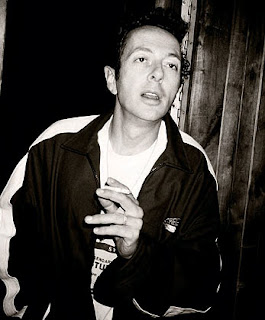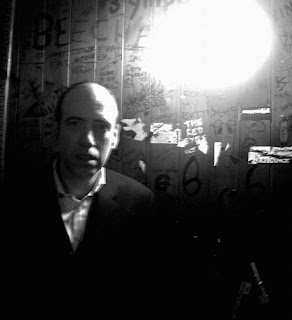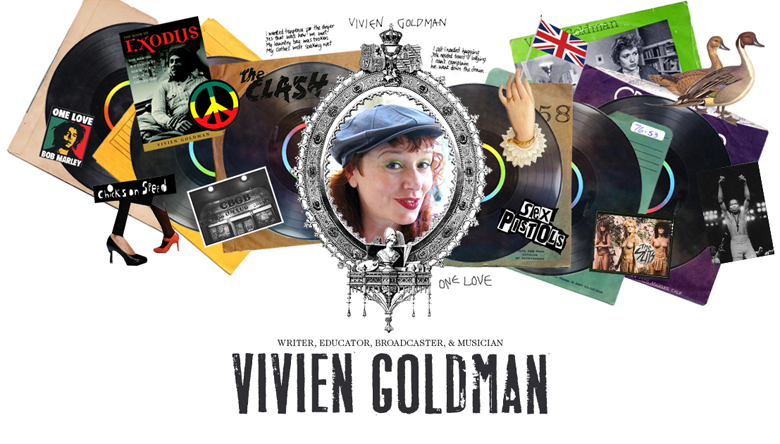Welcome to our second lesson, Class, and what are those suspicious noises coming from your laptop, you in the back there? Please remember that computers are only to be used in class for making notes, definitely not for viewing banned material.
No woman is an island and happily, the Punk Professor has gathered an elite cadre of spies to serve this column's community, all longstanding comrades in punk who continue to make a great contribution. Today's reports come from Chris Salewicz in London and Amy Linden in New York and indicate that many of the pupils of the Punk Class of '76 and '77 who lived to tell the tale are still at the top of their class.
Going back to their roots, Patti Smith, Lenny Kaye, Jay Dee Daugherty and Tony Shanahan played a small show in the storied Chelsea Hotel, a bonafide boho hangout that was Dylan Thomas' home at the time of his death. When she first arrived in New York, the Chelsea was home to Smith and her close friend, the late photographer Robert Mapplethorpe. It was a low-key but typically intense Patti presentation to announce her new release, Twelve, - an album of covers from one of punk's more formidable auteurs. Perhaps the prototypical Punky Mummy, Smith took some years out to devote herself to her children and her late husband, Fred "Sonic" Smith, the guitar player for punk inspirations, the MC5. But her leave of absence from touring just seemed to feed Patti's commitment to total sincerity onstage and in the studio, so when she chose to cover songs by, among others, The Doors, Jimi Hendrix and Paul Simon she naturally followed her heart and stirred controversy; some critics found her rock-based selection to be predictable, others dug it. Always cosmically inclined, Patti munched on matzo in tribute to the second Passover Seder, which was taking place that same night. Linden notes that when an audience member asked Smith why she was doing Tears For Fears' "Everybody Wants To Rule The World," Smith came back with the classic punk zinger: "Because I want to."
And in London, the original members of the Clash are also still doing it their way. Après-Clash, bassist Paul Simonon initially reverted to his first calling as a visual artist, but has recently joined The Good, The Bad and the Queen, the band formed by Blur originator, Damon Albarn. When the much-loved West London theater immortalized by Clash singer Joe Strummer in "White Man at Hammersmith Palais" finally closed recently, Simonon's band played the night before last - the ultimate honors of sending off the venerable venue went to Mancunians, The Fall.

(Joe Strummer from the book, Out Of Mind courtesy of Shawn Mortensen)

(Mick Jones of Carbon/Silicon courtesy of Carbon/Silicon)
Listening to Carbon/Silicon's music online -apparently they intend to put all their songs up for free -one hears an odd yet inevitable sound: mature punk. These rhythms indicate artists who've been there, done that, with a range of styles - punk, funk, reggae, dub -- always reaching for the DNA of what moves them, and finding their answer in a sometimes almost skeletal sound that suggests a new way to dance. Jones' freeform rants are both pungent and pointed. Grown folks' wisdom informs lyrics like these from "Prophet":
No woman is an island and happily, the Punk Professor has gathered an elite cadre of spies to serve this column's community, all longstanding comrades in punk who continue to make a great contribution. Today's reports come from Chris Salewicz in London and Amy Linden in New York and indicate that many of the pupils of the Punk Class of '76 and '77 who lived to tell the tale are still at the top of their class.
Going back to their roots, Patti Smith, Lenny Kaye, Jay Dee Daugherty and Tony Shanahan played a small show in the storied Chelsea Hotel, a bonafide boho hangout that was Dylan Thomas' home at the time of his death. When she first arrived in New York, the Chelsea was home to Smith and her close friend, the late photographer Robert Mapplethorpe. It was a low-key but typically intense Patti presentation to announce her new release, Twelve, - an album of covers from one of punk's more formidable auteurs. Perhaps the prototypical Punky Mummy, Smith took some years out to devote herself to her children and her late husband, Fred "Sonic" Smith, the guitar player for punk inspirations, the MC5. But her leave of absence from touring just seemed to feed Patti's commitment to total sincerity onstage and in the studio, so when she chose to cover songs by, among others, The Doors, Jimi Hendrix and Paul Simon she naturally followed her heart and stirred controversy; some critics found her rock-based selection to be predictable, others dug it. Always cosmically inclined, Patti munched on matzo in tribute to the second Passover Seder, which was taking place that same night. Linden notes that when an audience member asked Smith why she was doing Tears For Fears' "Everybody Wants To Rule The World," Smith came back with the classic punk zinger: "Because I want to."
And in London, the original members of the Clash are also still doing it their way. Après-Clash, bassist Paul Simonon initially reverted to his first calling as a visual artist, but has recently joined The Good, The Bad and the Queen, the band formed by Blur originator, Damon Albarn. When the much-loved West London theater immortalized by Clash singer Joe Strummer in "White Man at Hammersmith Palais" finally closed recently, Simonon's band played the night before last - the ultimate honors of sending off the venerable venue went to Mancunians, The Fall.

(Joe Strummer from the book, Out Of Mind courtesy of Shawn Mortensen)
However, Clash guitarist and songwriter, Mick Jones, never stopped making music. After the Clash came Big Audio Dynamite (B.A.D) featuring two Dreads who helped put the reggae in punk, long time bred'ren Leo Williams and Don Letts, better known as a DJ, film-maker and recently, author. Now Jones has an intriguing outfit called Carbon/Silicon, put together with his old mates, the estimable Tony "T.J." James, and Leo Williams. Both James and Jones have fertile minds. In fact, James' previous bands have often seemed to be conceptual ripostes to the zeitgeist, as in the Op Art punk popsters Generation X with Billy Idol, followed by James' reinvention sporting an absurdist pink wig with post-post-punk posers Sigue Sigue Sputnik. Throughout he has remained a terrific bass player with a great sense of fun - and indeed, much flexibility, as he's currently playing guitar.
(Mick Jones of Carbon/Silicon courtesy of Carbon/Silicon)
Listening to Carbon/Silicon's music online -apparently they intend to put all their songs up for free -one hears an odd yet inevitable sound: mature punk. These rhythms indicate artists who've been there, done that, with a range of styles - punk, funk, reggae, dub -- always reaching for the DNA of what moves them, and finding their answer in a sometimes almost skeletal sound that suggests a new way to dance. Jones' freeform rants are both pungent and pointed. Grown folks' wisdom informs lyrics like these from "Prophet":
"Ain't no profit/Being a prophet/Ain't no kudos being right/But it gets you through the night." Those words suggest a man who has learned that while compromise isn't necessarily always as bad as hard-line Punk says, the truth will always be non-negotiable.
Our London spy, Chris Salewicz, author of the epic new biography, Redemption Song: The Ballad of Joe Strummer, happened on the band playing a down-low show at their rehearsal space in the charmingly untrendy enclave of North Acton. Reports Salewicz, "They've been working on it for four years. Mick Jones looked unbelievably happy, beaming with joy. The material is fantastic, probably the best he's ever written, like the new single, "The News", which is all about positivity and the conspiracy to bring us all down. Quite a lot of blokes of a certain age there had tears in their eyes."
From the start, Clash front man Joe Strummer knew how to pose -- throw a smoldering glance, strike a tough stance. For this warm view of Joe, and many other more anonymous folk who the photographer also knows to be stars, see the bold new photo anthology from Shawn Mortensen, Out of Mind. A gentleman adventurer whose natural habitat is the front line, Mortensen is a generous, genial type who's also a good host. With his first wife, Gaby, Strummer once wound up crashing in Mortensen's LA pad, and this portrait shows a Strummer I remember: droll, scathing, and always engaged in some great debate. As a fashion photographer, Mortensen loves to shatter industry expectations. He brings the same humanity and fine eye to photographing gunmen in Kingston or South African AIDS activists in flowing scarlet head wraps and robes. Whatever the subject, Mortensen's sensibility is strictly rad punk, fresh and ever ready for the revolution.
Now our time's up, and just before you leave - quietly, please, we've had some complaints -- a quick word regarding our host. If any of you were also hooked on French & Saunders and can quote chunks of Absolutely Fabulous word for word, are you aware that the old team has a new BBC America series called Clatterford? Put it this way, if I A) had a TIVO and B) knew how to operate it, Clatterford''s one to record. For real.
Class dismissed. We'll re-convene in two weeks.
This week's question:
Why did biographer Chris Salewicz name his biography of Joe Strummer after a song by Bob Marley?
OUR READER'S QUESTION:
It seemed like punk was a rejection of most everything that came before - but of course, that really is impossible. Who were the most important predecessors and influences upon punk? Who were the influences that perhaps the punks wouldn't want to admit to?
-- Noah Simon
Thanks for the perspicacious question, young Noah.
The roots of punk spread far and deep, though it magically seemed to spring from the air at the time. A blend of psychedelia and agit-pop whirl in the punk centrifuge:
T Rex, the MC5, Albert Ayler, Burning Spear and 1930s anti-Fascist collage artist John Heartfield, glam rockers, flag burners, teddy boys and fetish girls, marching leftist students in Paris in 1968. They all fuse, or maybe explode, in punk, along with much more. Personally, I've always been drawn to the libertarian, pagan, Druidic aspect of punk, personified in its most celebrated visualiser, Jamie Reid, the political artist and Druid priest who designed the Sex Pistols' sleeves and came up with the now classic conceit of using "kidnap" cut-out lettering. As to Punk's Dirty Little Secret, the influence that dare not speak its name -- here, images of a long-haired teenage schoolboy Johnny Rotten come to mind - it is the quiet punk penchant for longhaired UK hippy jam bands like Hawkwind and the Pink Fairies. The Sex Pistols' singer always had the sense to claim all his influences proudly even at the height of punk's dictum: The only good hippy's a dead hippy. That's partly why Rotten became a true Punk Archetype. Like my comrade in punk, artist and writer Caroline Coon, whose activism spanned both those eras and still continues, I know the superficially contradictory creeds -- the hippies' All You Need Is Love and punk's No Future/Blank Generation -- to be two sides of the same shiny coin, that both pay in positivity.
From the start, Clash front man Joe Strummer knew how to pose -- throw a smoldering glance, strike a tough stance. For this warm view of Joe, and many other more anonymous folk who the photographer also knows to be stars, see the bold new photo anthology from Shawn Mortensen, Out of Mind. A gentleman adventurer whose natural habitat is the front line, Mortensen is a generous, genial type who's also a good host. With his first wife, Gaby, Strummer once wound up crashing in Mortensen's LA pad, and this portrait shows a Strummer I remember: droll, scathing, and always engaged in some great debate. As a fashion photographer, Mortensen loves to shatter industry expectations. He brings the same humanity and fine eye to photographing gunmen in Kingston or South African AIDS activists in flowing scarlet head wraps and robes. Whatever the subject, Mortensen's sensibility is strictly rad punk, fresh and ever ready for the revolution.
Now our time's up, and just before you leave - quietly, please, we've had some complaints -- a quick word regarding our host. If any of you were also hooked on French & Saunders and can quote chunks of Absolutely Fabulous word for word, are you aware that the old team has a new BBC America series called Clatterford? Put it this way, if I A) had a TIVO and B) knew how to operate it, Clatterford''s one to record. For real.
Class dismissed. We'll re-convene in two weeks.
This week's question:
Why did biographer Chris Salewicz name his biography of Joe Strummer after a song by Bob Marley?
OUR READER'S QUESTION:
It seemed like punk was a rejection of most everything that came before - but of course, that really is impossible. Who were the most important predecessors and influences upon punk? Who were the influences that perhaps the punks wouldn't want to admit to?
-- Noah Simon
Thanks for the perspicacious question, young Noah.
The roots of punk spread far and deep, though it magically seemed to spring from the air at the time. A blend of psychedelia and agit-pop whirl in the punk centrifuge:
T Rex, the MC5, Albert Ayler, Burning Spear and 1930s anti-Fascist collage artist John Heartfield, glam rockers, flag burners, teddy boys and fetish girls, marching leftist students in Paris in 1968. They all fuse, or maybe explode, in punk, along with much more. Personally, I've always been drawn to the libertarian, pagan, Druidic aspect of punk, personified in its most celebrated visualiser, Jamie Reid, the political artist and Druid priest who designed the Sex Pistols' sleeves and came up with the now classic conceit of using "kidnap" cut-out lettering. As to Punk's Dirty Little Secret, the influence that dare not speak its name -- here, images of a long-haired teenage schoolboy Johnny Rotten come to mind - it is the quiet punk penchant for longhaired UK hippy jam bands like Hawkwind and the Pink Fairies. The Sex Pistols' singer always had the sense to claim all his influences proudly even at the height of punk's dictum: The only good hippy's a dead hippy. That's partly why Rotten became a true Punk Archetype. Like my comrade in punk, artist and writer Caroline Coon, whose activism spanned both those eras and still continues, I know the superficially contradictory creeds -- the hippies' All You Need Is Love and punk's No Future/Blank Generation -- to be two sides of the same shiny coin, that both pay in positivity.
